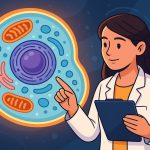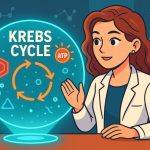Mitochondria are among the most fascinating and essential organelles in all living cells. Often called the “powerhouses of the cell,” they are responsible for producing the energy necessary for life. But these tiny structures are far more than simple generators — they are dynamic, multifunctional components that influence everything from metabolism to aging and even cell death. Understanding mitochondria provides insight into both the beauty and complexity of biological systems, as well as the delicate balance that sustains human health.
The Structure and Function of Mitochondria
Mitochondria are double-membrane organelles found in almost all eukaryotic cells — from muscle fibers to neurons. The outer membrane serves as a protective barrier, while the inner membrane folds into structures called cristae, which greatly increase surface area for chemical reactions. Inside lies the matrix, a fluid containing enzymes, DNA, and ribosomes. This internal environment is where the Krebs Cycle and oxidative phosphorylation occur, two critical processes that convert nutrients into energy-rich molecules of adenosine triphosphate (ATP). Every heartbeat, thought, and movement depends on ATP produced by mitochondria, making them vital for survival.
The Energy Conversion Process
The production of ATP within mitochondria happens through cellular respiration, a process that involves breaking down carbohydrates, fats, and proteins. The key steps are the Krebs Cycle and the electron transport chain (ETC). In the ETC, electrons from NADH and FADH₂ — molecules generated during earlier metabolic steps — pass through a series of protein complexes, releasing energy used to pump protons (H⁺) across the inner membrane. This creates an electrochemical gradient that drives the synthesis of ATP through the ATP synthase enzyme. In this way, mitochondria transform chemical energy from food into the electrical energy that fuels life.
The Origin and Evolution of Mitochondria
One of the most intriguing facts about mitochondria is their evolutionary history. According to the endosymbiotic theory, mitochondria originated about two billion years ago when a primitive eukaryotic cell engulfed a free-living bacterium. Instead of being digested, this bacterium formed a symbiotic relationship with its host, exchanging nutrients and energy. Over time, the two organisms merged, and the bacterium evolved into the modern mitochondrion. This theory is supported by the fact that mitochondria contain their own DNA, which is circular and resembles bacterial genetic material. This ancient partnership shows how cooperation in nature can lead to evolutionary success.
The Role of Mitochondria in Health and Disease
Because mitochondria are central to energy production, even small malfunctions can have significant health consequences. Mitochondrial diseases occur when the DNA within mitochondria (or the genes controlling them) becomes damaged. Such conditions can affect high-energy organs like the brain, heart, and muscles, leading to fatigue, neurodegeneration, and metabolic disorders. Recent studies have also linked mitochondrial dysfunction to aging, diabetes, and neurodegenerative diseases such as Alzheimer’s and Parkinson’s. Researchers believe that damage caused by oxidative stress — the buildup of harmful free radicals — contributes to the gradual decline in mitochondrial efficiency with age.
Beyond Energy – The Many Functions of Mitochondria
Although their main function is energy production, mitochondria are also involved in cell signaling, apoptosis (programmed cell death), and calcium storage. In the immune system, mitochondria help activate defense mechanisms against infections. They also play a role in controlling cell growth and differentiation, making them crucial for tissue repair and development. Furthermore, recent research shows that mitochondria communicate with the cell nucleus to coordinate energy demands and stress responses, a relationship known as mitonuclear signaling. This complex communication network allows cells to adapt to changes in their environment efficiently.
Expert Opinions on Mitochondrial Science
According to Dr. Douglas Wallace, one of the world’s leading mitochondrial geneticists, “Mitochondria are not just power plants — they are central regulators of life and death.” His research has shown that mitochondrial DNA mutations can explain many chronic diseases that traditional genetics cannot. Meanwhile, Dr. Rhonda Patrick, a biomedical scientist, emphasizes that lifestyle factors such as nutrition, exercise, and sleep directly influence mitochondrial health. Physical activity, for instance, stimulates mitochondrial biogenesis, the creation of new mitochondria, which enhances energy levels and resilience. These insights reveal that understanding mitochondria is not only a matter of biology but also of longevity and well-being.
The Future of Mitochondrial Research
Modern science continues to uncover new dimensions of mitochondrial function. Advances in nanotechnology and genetic therapy are paving the way for potential treatments that could repair or replace damaged mitochondria. Researchers are also exploring mitochondrial transfer, where healthy mitochondria are transplanted into damaged cells to restore function — a technique showing promise in regenerative medicine. Furthermore, understanding mitochondrial communication may hold the key to slowing aging and treating metabolic and neurodegenerative diseases. As scientists delve deeper, mitochondria continue to prove that they are more than energy producers — they are the guardians of cellular vitality.
Interesting Facts
- Mitochondria have their own DNA, inherited almost exclusively from the mother.
- Each human cell contains between 100 and 2,000 mitochondria, depending on energy needs.
- About 90% of the body’s energy is generated by mitochondria.
- Mitochondria can move, divide, and fuse within cells to adapt to energy demands.
- Exercise increases both the number and efficiency of mitochondria in muscle cells.
Glossary
- Mitochondria – Organelles that generate energy through cellular respiration.
- ATP (Adenosine Triphosphate) – The primary molecule that stores and transfers energy in cells.
- Krebs Cycle – A series of chemical reactions that generate energy carriers for the electron transport chain.
- Electron Transport Chain – A process that uses electrons to produce ATP.
- Endosymbiotic Theory – The theory that mitochondria originated from ancient bacteria living inside early cells.
- Oxidative Stress – Damage caused by free radicals, unstable molecules that harm cellular structures.
- Apoptosis – Programmed cell death, a natural process for maintaining tissue health.
- Mitonuclear Signaling – Communication between mitochondria and the cell nucleus.
- Mitochondrial DNA (mtDNA) – Genetic material found inside mitochondria.
- Mitochondrial Biogenesis – The process of forming new mitochondria within a cell.


